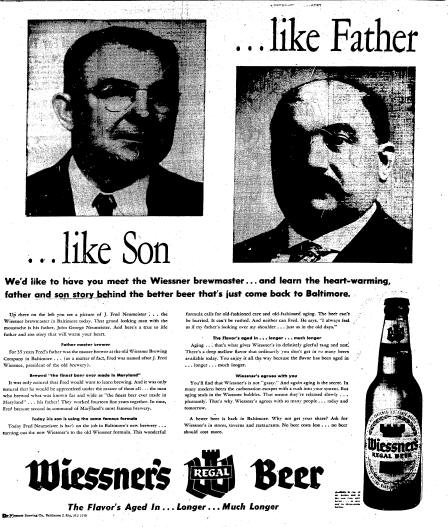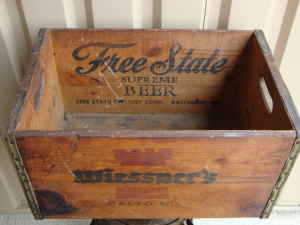Wiessner's Regal Pale, 1950-52.
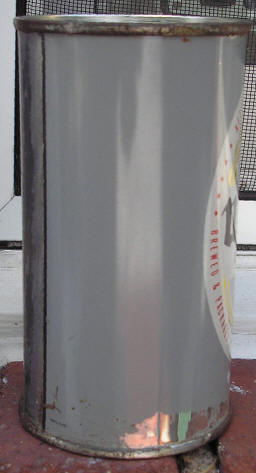 |
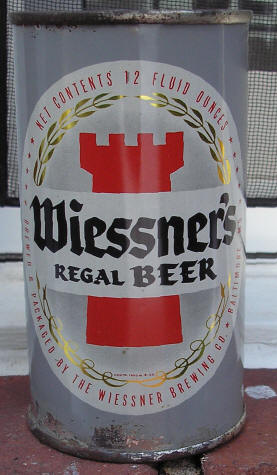 |
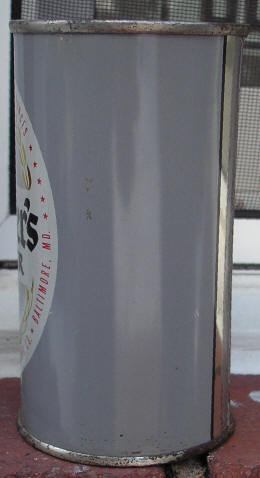 |
This month’s can is from a very short-lived brewery in Baltimore. The Wiessner Brewing Company was in business for less than two years and left only two cans for collectors. The COM pictured above is the less rare of the two and probably deserves a 7 on the “Dumper’s Guide to Rareness” (most advanced local collectors will have one but it’s always a welcome find on dumping trips). In the past several years I’ve seen one dumped once, in January 2007, and we only found one badly damaged example. The rarer can does not have the word "Regal" on the front but has the word "Premium." I've never dumped one.
Wiessner Brewing 1950-1952
The Wiessner company was created in May 1950 at the site of the former Free State Brewery in Baltimore. Free State could trace its beginnings back to 1900 as the American Brewery. Reopened after Prohibition as the Free State Brewery, it never really had much market share and finally closed in May 1950. Only three days later the Wiessner Company opened in the same plant. The new company was headed by Morton Sarubin. A local clothing merchant, Sarubin owned the Regal Shop, which sold men’s and woman’s clothing on West Baltimore Street. The brewery’s new beer was named Regal after Sarubin’s business, which makes this, as far as I can tell, the only beer named after a clothing store.
The brewery name, Wiessner, was chosen because of its ties to the pre-prohibition glory days of the Baltimore brewing industry. George Wiessner had opened the first Wiessner Brewery in 1869. It later became the John F. Wiessner and Brother Brewery. In 1899 it was one of several Baltimore breweries which were absorbed into the Maryland Brewing Company. (see my Arrow Beer page for more). The Wiessner's later opened John F. Wiessner & Sons Brewery on Gay Street in Baltimore.
The new brewery didn't just use the old name. Wiessner’s new brewmaster was John F. Neumesiter. His father, John G. Neumesiter, had been brewmaster at the Wiessner brewery on Gay Street. John F. had apprenticed under his father at the old Wiessner Brewery and had worked at other Baltimore breweries after Prohibition. Some of the new brewery’s newspaper ads played up this historical connection to pre-prohibition Baltimore claiming that the new brewery’s beer was based on the old formula used by the original Wiessner family breweries.
Wiessner's Ad, June 1950. Using the Free State brewery also provided some advantages to Wiessner. Free State had added to and improved its facilities since reopening in 1933 and Sarubin continued to update the brewery’s equipment. A flat top canning line was added and production capacity was increased to 200,000 barrels a year, compared to the 60,000 that Free State was selling at the end of its business life. In the early Autumn of 1950 Wiessner’s was available in cans for the first time.
Walkie Talkies
In late 1951 Wiessner’s tried a new promotion called the “Walkie-Talkies.” A brewery spokesman wearing a giant Wiessner’s package would go into a bar and if he saw a person in there with an open bottle of Wiessner’s Beer, the “Walkie-Talkie” would buy the lucky winner two six packs of Wiessner’s Beer and the winner’s picture would appear in a Wiessner’s TV ad. The ads announcing the promotion were careful to note that the “Walkie-Talkie” would buy the 2 six packs from the bar paying the normal price. No doubt bar-tenders would have been reluctant to accept someone coming in and giving away their beer for free!
Things did not go smoothly for the new company. The established breweries in Baltimore were not happy to see the new competition. In late 1951 Wiessner’s filed a lawsuit against their local competitors; American Brewery, Globe, Gunther and National Brewing. Associated Brewers (a regional collection of small breweries) was also named in the suit. Wiessner claimed that the other breweries conspired to eliminate competition by fixing prices. The four breweries, according to the complaint, had agreed not to take customers from each other (by customers they meant bars and restaurants, not individual drinkers). If, for example, a bar decided to drop Gunther, the other three plaintiffs agreed not to sell beer to the customer for six months. Wiessner claimed that when they did not follow this gentleman's agreement, being unaware it existed, that the four brewers conspired to concentrate on taking over only Wiessner's customers. Wiessner claimed that this had resulted in a loss of $500,00 and they asked for $1,500,000 in damages.
A Wiessner's crate. I like how they recycled a Free State crate.
Wiessner was itself sued in May 1952 by two of its own stockholders, who noted that the brewery had lost over $180,000 in 1951. The suit claimed that the brewery had assets of only $127,000 and debts of more than $338,000. The suit was dismissed in June 1952 by the consent of both parties and the brewery closed. In early 1953 Edwin Sarubin, Morton’s brother, purchased the remaining stock for $650,000 and sold the brewing equipment and property. Some of the brewery buildings became a warehouse for General Electric Supply Company and the rest were torn down in 1956 to make a parking lot.
Sources Used:
“Breweries Remembered” American Breweriana Journal. (May-June 1995)
Kelly, William. Brewing in Maryland: From Colonial Times to the Present. (1965)
Modern Brewery Age (June 1950)
Modern Brewery Age (October 1950)
Modern Brewery Age (October 1951)
Modern Brewery Age (November 1951)
Modern Brewery Age (December 1951)
Modern Brewery Age (February 1952)
John F. Wiessner & Sons Brewery: Americanbreweriana.org (site no longer active)

